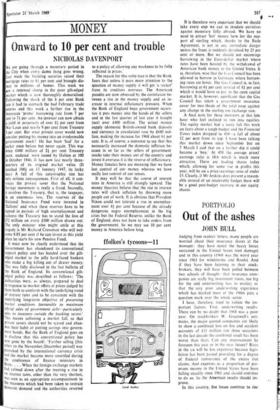Out of the ashes
PORTFOLIO
JOHN BULL
Judging from readers' letters, many people are worried about their insurance shares at the moment : they have noted the heavy losses sustained in the United States (riot damage) and in this country (1968 was the worst year since 1963 for windstorms and floods). And if they have been listening to their stock- brokers, they will have been pulled between two schools of thought—that insurance com- panies are really big investment trusts, too big for the odd underwriting loss to matter; or that the very poor underwriting experience which has marked most of the 1960s puts a question mark over the whole sector.
I have, therefore, tried to isolate the im- portant factors. First, underwriting results. There can be no doubt that 1968 was a poor year. On stockbrokers W. Greenwell's esti- mates, the major quoted companies are likely to show a combined loss on fire and accident accounts of fl 1 million (on three occasions in the last decade the combined result has been worse than that). Can any improvement be foreseen this year or in the near future? Riots in the us will be less expensive because legis- lation has been passed providing for a degree of Federal reinsurance of the excess riot claims. And expenses as a proportion of pre- mium income in the United States have been falling steadily since 1961 and should continue to do so. So the American results should im- prove.
In this country, fire losses continue to rise pretty sharply (up from £90 million to £100 million in 1968) and the marginally profitable motor insurance market may plunge into the red if the ending of the tariff (really a rate- fixing cartel) leads to excessive price-cutting (certainly there are some signs of this). To these difficulties one can add, however, some more favourable factors. The recent bout of mergers should lead to considerable cost sav- ings. And there are signs that the quality of top management has improved. All the same, it is not easy to be particularly hopeful about the outlook for underwriting in this country.
Luckily, there is much more to the big com- posite insurance groups, to companies like Commercial Union, Royal Insurance, General Accident, Guardian Royal Exchange, Eagle Star, Sun Alliance London, Phoenix and the Prudential. They all have very large invest- ment incomes. This arises partly because a large part of premium income is invested until needed to pay claims. Thus insurance com- panies can stand a certain degree of under- writing loss and still make an overall profit. If this is taken into account, then the big in- surance companies made a profit in every year but one in the decade 1958 to 1967, though on underwriting results alone there was a profit in only two years. Moreover, all insur- ance companies have substantial reserves left over from past years' underwriting, which is why total investment income is so massive.
In addition, life business provides the in- surance companies with a considerable source of strength. Profits from life business have been growing at an annual rate of 18f per cent compound over the past ten years. Life assurance is sometimes thought to be a mys- terious business but, in tact, its profitability
Valuations at 19 March 1969 First portfolio 100 Empire Stores at 65s 6d . • 125 Phoenix Assurance at 41s 9d 330 Witan at 21s 3d ..
500 E. Scragg at 19s • • . • 500 Clarkson (Engineers) at 18s 60 Rio Tinto Zinc at 141s 1,000 Associated British Foods at lOs 3d 1,000 Jamaica Public Service at 6s lid .. 200 Associated British Picture at 33s 9d 100 Lyons `A' at 79s 200 British and Commonwealth at 43s 3d .. • • • 200 Forte's Holdings at 40s . 400 Bowmaker at 26s 9d 1,000 English Calico at 9s 1 fd .
Cash in hand .. • • • £6,755
Deduct: expenses £246
Total £6,509 Second portfolio 600 Pillar Holdings at 18s 1 lid 15 Kaiser Steel at £36 8s ..
250 Lonrho at 62s • • • • 100 British Petroleum at 137s 6d
300 Vosper at 20s 9d • • • • 1,000 Allied Breweries at 20s 9d 300 I. Bibby at Vs 6d
Cash in hand • . • • • • £5,797
Deduct: expenses £173
Total £5,624
• • • • • • • •
£327 £261 £350 £475 £450 £453 £513 £306 £337 £395 Shipping • .. £433 . f400 . £535 . £456 . £1,064
.. £568 .. £546 .. £775 .. £688 .. £311 .. £1,037 .. £413 . . £1,459 depends upon three ietatively simple factor; expenses, mortality (the calculation of which is a pretty precise business) and earnings oil premium income. Its growth potential depends upon the way the highly competitive savings market turns out and there are two develo ments which the life departments have to watch closely, the growth of unit trusts and the Uri. pact of the new government plans for pensions on occupational schemes Thus to set against poor underwriting ex perience the composites have two sources o strength, their investment income and profits from their life departments. Some companies are better off than others. Greenwell's have compiled a table which sums up the whole sub. ject : it indicates the level of profitability at which fire and accident business can operate so that present dividends are covered once by earnings. Eagle Star comes out top of this table, followed by Guardian Royal Exchange and Phoenix, then Commercial Union and General Accident. Bottom is the Sun Alliance London. My own conclusion is that the 1968 losses are not as serious as they look and that insurance shares provide a steady but Unspectacular investment. Phoenix is the sole representative in my two portfolios, and 1 shall hold it for the time being.











































 Previous page
Previous page